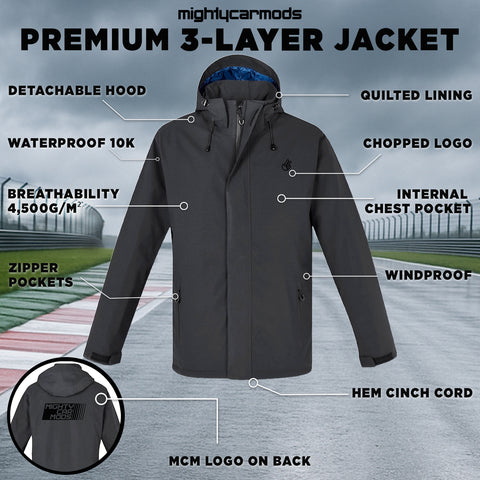
How to buy used parts
If you're hunting cheap parts like Marty is with the CASH vs TRASH series, then you'll wind up buying second-hand bits. Side note, if you need to catch up check out the COILOVERS EPISODE (CLICK HERE), the POD FILTERS (CLICK HERE), and the latest, greatest episode on MAKING EXHAUSTS (CLICK HERE).
Sometimes it is actually preferable to buy used high-quality parts instead of simply picking up the cheapest brand new parts you can, as these can be nasty low-quality junk. There can be some pitfalls to buying used parts, so this week I'll give you tips on how to buy used car parts, as this is something I've done for years with a stack of my projects (like my Burgundy Ron Subaru and DirtE30 builds, seen below).

If you're buying second-hand parts you really should inspect them before splashing your cash down. Even when you know the car and the parts you're buying you should inspect them, though this can be difficult if they're for sale online and a long way from your location.
Asking the seller for detailed photos showing the condition and asking specifically for details of any problems or defects can help. Or getting a trusted friend experienced with those parts to go inspect the part for you is a good idea, too.

If you're looking at buying something advertised as a "swap kit" then spend time inspecting the photo(s) to make sure all the parts you need are actually there. I purchased the parts shown above as a "complete six-speed swap" for a Subaru wagon I was building... except keen eyes might notice the kit pictured above is missing the rear diff centre and two CV shafts. I asked the seller to confirm those parts were included and, thankfully, they were.

When buying engines and mechanical parts it pays to take a second person with you, as they can spot issues you might gloss over in your rush to buy this dort-making piece of hotness. If you can't see the engine running, turn it over by hand and listen for any rattles or clanks, and make sure it spins butter-smooth.
If it doesn't rotate smoothly then it has internal issues, and that is a danger sign for your wallet. If the engine is advertised as needing a rebuild, ask the seller why and what is wrong with it. It also pays to ask the seller where they got the engine from, and what specifically it is out of so you can double-check it is indeed as advertised.

You should also, at bare minimum, check the colour of the oil and look for where oil or fluids may have leaked from. Check for any and all damage, missing parts, and burned wiring. If you have time and space, pull the spark plugs out, inspect them and, while plugging the holes, turn the engine over to give a bush-spec compression check - doing this has saved me from buying an engine where two pistons out of six were missing their ring-lands!

If the parts are massively cheaper than what you've normally seen them for sale for, then you need to ask yourself (and the seller) why. Are they selling counterfeit parts as the real deal? Are these stolen parts? Or is the seller trying to palm off broken parts, or parts needing rebuilding, to unsuspecting noobs?
I bought some Recaros a while back and, before spending my money, I did some searching on Google to learn how to tell a genuine Recaro LS from a fake. And while the seats I was interested in turned out to be genuine, I wanted to be sure they were given their price.

Before you buy parts that you can't physically go and pick up, it pays to get freight quotes. Australia is a huge country and it is expensive to send stuff around it, so there have been plenty of times I've had to pass up parts I needed or wanted because the cost of shipping them interstate made them uneconomical to buy.
The Getrag transmission pictured above cost me $200 from a mate in Brisbane, but I was quoted $700 to freight it 900km to me in Sydney. Luckily, I asked around my mates and was able to pay a friend to bring it with him as he travelled back to Sydney; this can be a great way to get parts you need delivered far cheaper than paying retail logistics rates.

All in all, buying used parts is great as you can build up a stash of spares, and restoring them for use on your project is a great skills-building exercise. I funded one of my BMW E30 builds through buying and selling vintage BMW parts, and trading for parts I needed.
Today, there are plenty of ways to buy great used parts, including eBay, Gumtree, Facebook Marketplace, and specific Facebook groups, too. So, before you buy the cheapest, nastiest low-quality new parts, have a look around your used options.


![Limited Edition Budget Street Cred Golf Poster [AUTOGRAPHED]](http://mightycarmods.com/cdn/shop/files/FullSizeRender_480x480.jpg?v=1760910149)
![Boosty Boi T-Shirt [Black Edition]](http://mightycarmods.com/cdn/shop/files/DSC2662_b504777a-ecdc-4da2-8b18-b4b525bce4d5_480x480.jpg?v=1759355323)
![Chopped MCM Hoodie [Black Edition]](http://mightycarmods.com/cdn/shop/files/DSC2445_d41795ae-8f15-4257-8ae2-60623a893824_480x480.jpg?v=1759099951)
